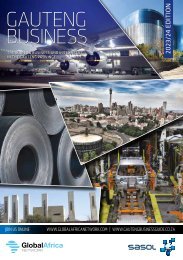Mpumalanga Business 2019/20 edition
The 2019/20 edition of Mpumalanga Business is the tenth issue of this highly successful publication that since its launch in 2008 has established itself as the premier business and investment guide for the province. In addition to the regular articles providing insight into each of the key economic sectors of the province, there is a special focus on the new life given to an established site at the Highveld Industrial Park and the Nkomazi Special Economic Zone (NSEZ). A useful article on what incentives are available to investors is included, and the Mpumalanga Economic Growth Agency (MEGA) gives investors some perspectives on what is available in the province. Mpumalanga has several investment and business opportunities in a wide range of sectors. Updated information on Mpumalanga is also available through our monthly e-newsletter, which you can subscribe to online at www.gan.co.za, in addition to our complementary business-to-business titles that cover all nine provinces as well as our flagship South African Business title. Chris Whales Publisher, Global Africa Network Media
The 2019/20 edition of Mpumalanga Business is the tenth issue of this highly successful publication that since its launch in 2008 has established itself as the premier business and investment guide for the province.
In addition to the regular articles providing insight into each of the key economic sectors of the province, there is a special focus on the new life given to an established site at the Highveld Industrial Park and the Nkomazi Special Economic Zone (NSEZ). A useful article on what incentives are available to investors is included, and the Mpumalanga Economic Growth Agency (MEGA) gives investors some perspectives on what is available in the province.
Mpumalanga has several investment and business opportunities in a wide range of sectors.
Updated information on Mpumalanga is also available through our monthly e-newsletter, which you can subscribe to online at www.gan.co.za, in addition to our complementary business-to-business titles that cover all nine provinces as well as our flagship South African Business title.
Chris Whales
Publisher, Global Africa Network Media
You also want an ePaper? Increase the reach of your titles
YUMPU automatically turns print PDFs into web optimized ePapers that Google loves.
OVERVIEW<br />
Forestry and paper<br />
Sawmills are generating energy.<br />
Sustainability is the modern watchword but finding a way to<br />
use resources for people is also popular.<br />
The MTO Group, which has 39 900ha of plantation<br />
under management in the Lowveld, teamed up in <strong>20</strong>18<br />
with mountain-bike enthusiasts of White River and Nelspruit to<br />
develop a set of trails through the hilly landscape of the area.<br />
One of the biggest operations in the forestry and paper sector<br />
in <strong>Mpumalanga</strong> is Sappi’s Ngodwana mill. The mill produces<br />
330 000 tons of paper pulp for its own consumption, 250 000<br />
tons of dissolving wood pulp (DWP) and 380 000 tons of paper<br />
(newsprint and kraft linerboard used for packaging) annually.<br />
Exports account for 70% of the mill’s product.<br />
Ongoing investment at Ngodwana Mill will contribute R13-<br />
billion to the provincial economy over <strong>20</strong> years. Sappi’s other large<br />
facility in the province, the Lomati Sawmill in Barberton, produces<br />
kiln-dried Southern African pine lumber from sawlogs supplied<br />
by Sappi Forests.<br />
The mill generates its own energy through co-generation<br />
(steam and electricity from renewable and other sources). In <strong>20</strong>17<br />
Sappi built a sugar extraction demonstration plant at Ngodwana.<br />
Findings from the experiment will help to improve the process<br />
of extracting bio-renewable chemicals. Sappi is partnering with<br />
Valmet, a Finnish company.<br />
Other forestry companies are looking into energy generation,<br />
including AFCOL. <strong>Mpumalanga</strong> has 40% of South Africa’s forestry<br />
resources. This fact presents an opportunity to exploit the sector’s<br />
byproducts in the biomass-to-energy field.<br />
The Zebra Pellets plant in Sabie is to be converted by national<br />
utility Eskom into a torrefied pellet plant. The wood will be provided<br />
to the plant (owned by the Industrial Development Corporation)<br />
and then heated without the use of oxygen (torrified) which creates<br />
a coal-like product without the carbon.<br />
SECTOR INSIGHT<br />
The MTO Group plants 18<br />
trees every minute.<br />
Forestry accounts for about<br />
8% of <strong>Mpumalanga</strong>’s gross<br />
domestic product. The sector<br />
comprises logging, saw-milling,<br />
wood product and pulp and<br />
paper manufacture. Pulp and<br />
paper are the main exports,<br />
along with sawn lumber, wood<br />
chips and wattle extract. Most<br />
sawn timber in South Africa is<br />
used in the construction sector.<br />
<strong>Mpumalanga</strong> has the ideal<br />
climate and topography for<br />
forests. Sabie and Graskop<br />
represent the hub of the industry,<br />
but commercial forests are also<br />
found to the east and south<br />
along the Swaziland border.<br />
About 11% of the land mass is<br />
forested, with 4% of that being<br />
natural forest. The province is the<br />
national leader in total hectares<br />
under forest (514 000ha) and in<br />
export earnings.<br />
Plans to develop an<br />
Agriculture and Forestry<br />
MPUMALANGA BUSINESS <strong><strong>20</strong>19</strong>/<strong>20</strong><br />
30


















